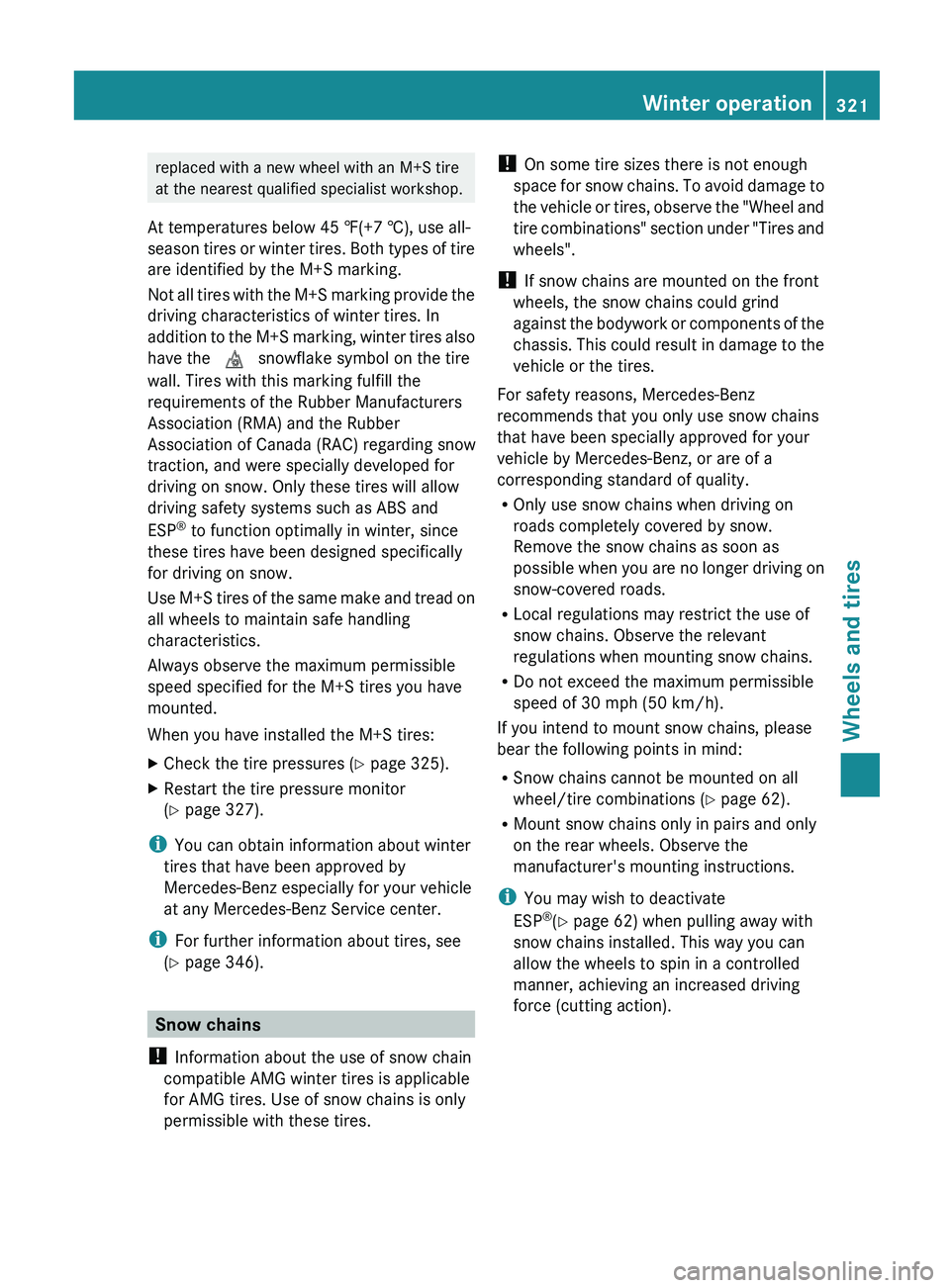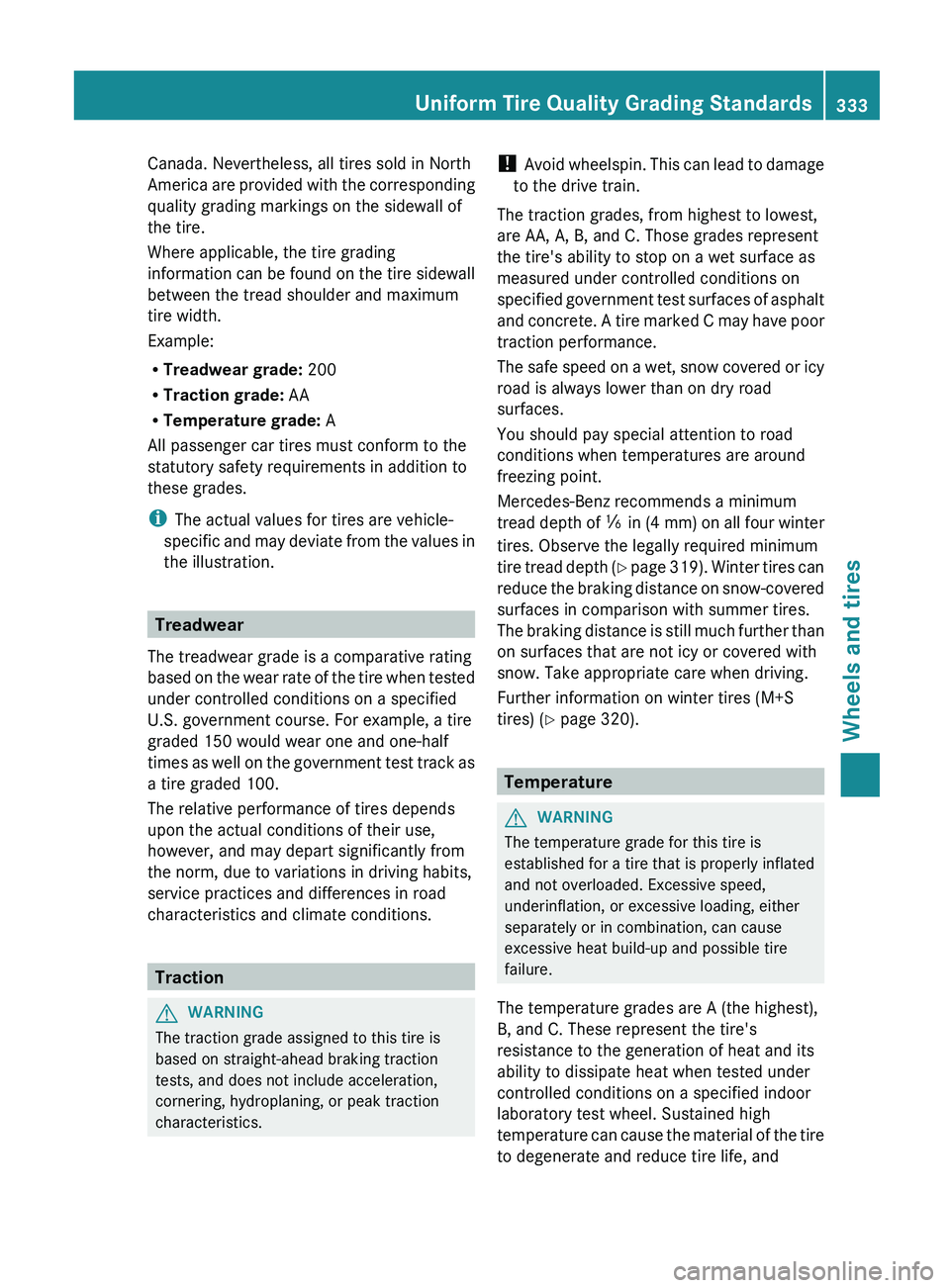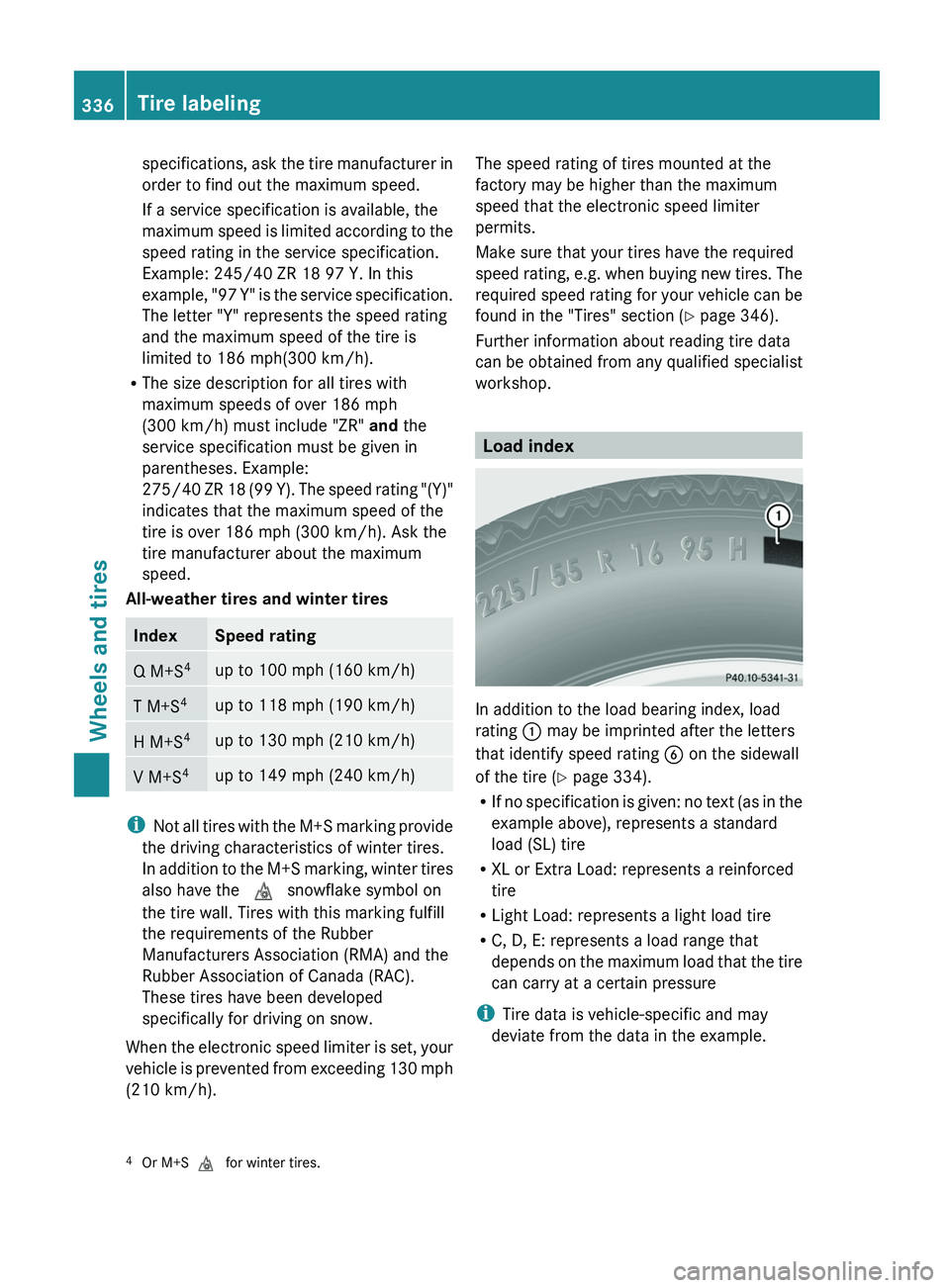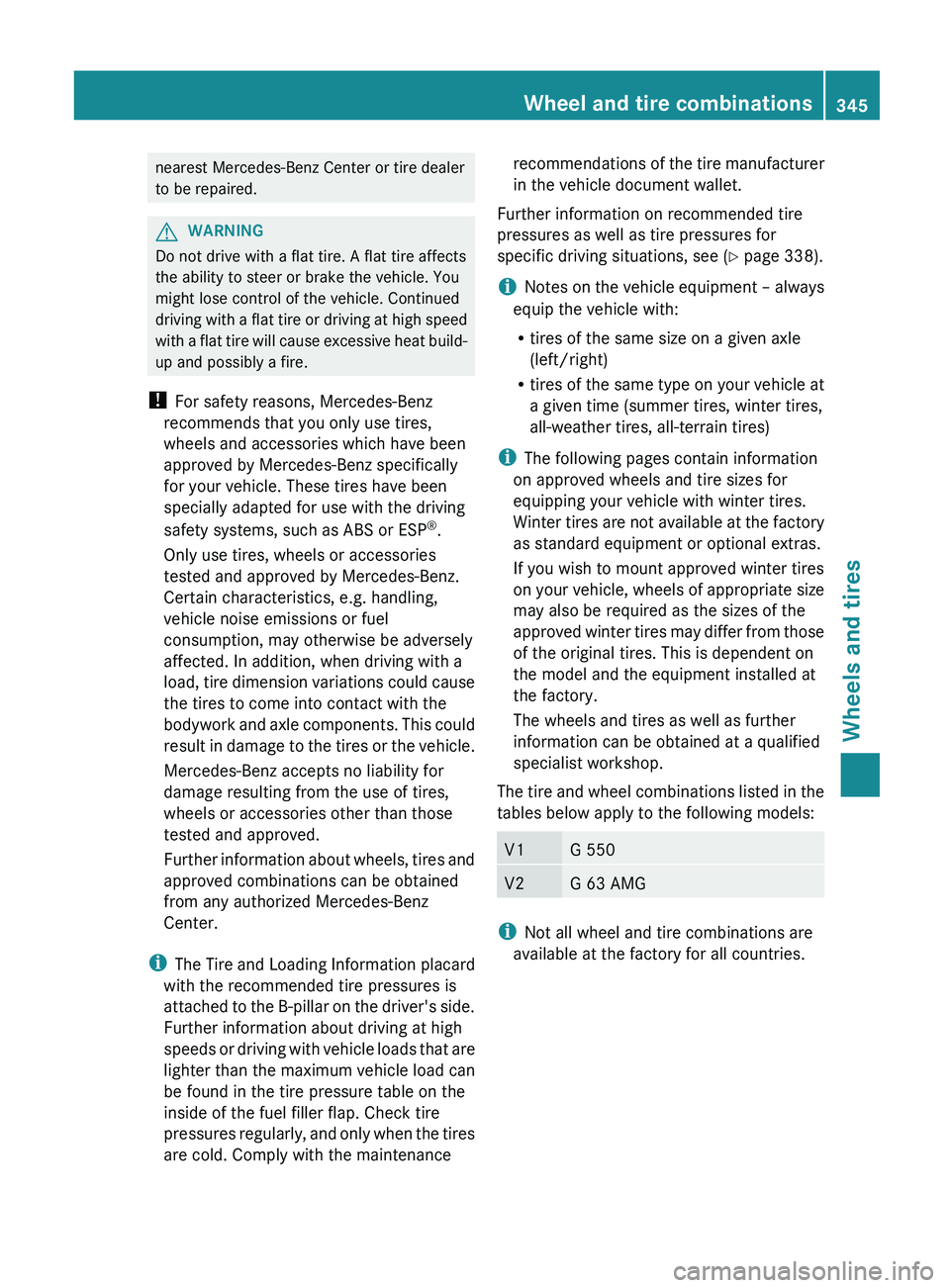2013 MERCEDES-BENZ G-CLASS SUV winter tires
[x] Cancel search: winter tiresPage 323 of 364

replaced with a new wheel with an M+S tire
at the nearest qualified specialist workshop.
At temperatures below 45 ‡(+7 †), use all-
season tires or winter
tires. Both types of tire
are identified by the M+S marking.
Not all tires with the M+S marking provide the
driving characteristics of winter tires. In
addition to the M+S marking, winter tires also
have the 004D snowflake symbol on the tire
wall. Tires with this marking fulfill the
requirements of the Rubber Manufacturers
Association (RMA) and the Rubber
Association of Canada (RAC) regarding snow
traction, and were specially developed for
driving on snow. Only these tires will allow
driving safety systems such as ABS and
ESP ®
to function optimally in winter, since
these tires have been designed specifically
for driving on snow.
Use M+S tires of the same make and tread on
all wheels to maintain safe handling
characteristics.
Always observe the maximum permissible
speed specified for the M+S tires you have
mounted.
When you have installed the M+S tires:
X Check the tire pressures (Y page 325).
X Restart the tire pressure monitor
(Y page 327).
i You can obtain information about winter
tires that have been approved by
Mercedes-Benz especially for your vehicle
at any Mercedes-Benz Service center.
i For further information about tires, see
(Y page 346). Snow chains
! Information about the use of snow chain
compatible AMG winter tires is applicable
for AMG tires. Use of snow chains is only
permissible with these tires. !
On some tire sizes there is not enough
space for snow chains.
To avoid damage to
the vehicle or tires, observe the "Wheel and
tire combinations" section under "Tires and
wheels".
! If snow chains are mounted on the front
wheels, the snow chains could grind
against the bodywork or components of the
chassis. This could result in damage to the
vehicle or the tires.
For safety reasons, Mercedes-Benz
recommends that you only use snow chains
that have been specially approved for your
vehicle by Mercedes-Benz, or are of a
corresponding standard of quality.
R Only use snow chains when driving on
roads completely covered by snow.
Remove the snow chains as soon as
possible when you are no longer driving on
snow-covered roads.
R Local regulations may restrict the use of
snow chains. Observe the relevant
regulations when mounting snow chains.
R Do not exceed the maximum permissible
speed of 30 mph (50 km/h).
If you intend to mount snow chains, please
bear the following points in mind:
R Snow chains cannot be mounted on all
wheel/tire combinations ( Y page 62).
R Mount snow chains only in pairs and only
on the rear wheels. Observe the
manufacturer's mounting instructions.
i You may wish to deactivate
ESP ®
(Y page 62) when pulling away with
snow chains installed. This way you can
allow the wheels to spin in a controlled
manner, achieving an increased driving
force (cutting action). Winter operation
321
Wheels and tires Z
Page 335 of 364

Canada. Nevertheless, all tires sold in North
America are provided
with
the corresponding
quality grading markings on the sidewall of
the tire.
Where applicable, the tire grading
information can be found on the tire sidewall
between the tread shoulder and maximum
tire width.
Example:
R Treadwear grade: 200
R Traction grade: AA
R Temperature grade: A
All passenger car tires must conform to the
statutory safety requirements in addition to
these grades.
i The actual values for tires are vehicle-
specific and may deviate from the values in
the illustration. Treadwear
The treadwear grade is a comparative rating
based on the wear
rate of the tire when tested
under controlled conditions on a specified
U.S. government course. For example, a tire
graded 150 would wear one and one-half
times as well on the government test track as
a tire graded 100.
The relative performance of tires depends
upon the actual conditions of their use,
however, and may depart significantly from
the norm, due to variations in driving habits,
service practices and differences in road
characteristics and climate conditions. Traction
G
WARNING
The traction grade assigned to this tire is
based on straight-ahead braking traction
tests, and does not include acceleration,
cornering, hydroplaning, or peak traction
characteristics. !
Avoid wheelspin. This can
lead to damage
to the drive train.
The traction grades, from highest to lowest,
are AA, A, B, and C. Those grades represent
the tire's ability to stop on a wet surface as
measured under controlled conditions on
specified government test surfaces of asphalt
and concrete. A tire marked C may have poor
traction performance.
The safe speed on a wet, snow covered or icy
road is always lower than on dry road
surfaces.
You should pay special attention to road
conditions when temperatures are around
freezing point.
Mercedes-Benz recommends a minimum
tread depth of 00CF in (4 mm) on all four winter
tires. Observe the legally required minimum
tire tread depth (Y page 319). Winter tires can
reduce the braking distance on snow-covered
surfaces in comparison with summer tires.
The braking distance is still much further than
on surfaces that are not icy or covered with
snow. Take appropriate care when driving.
Further information on winter tires (M+S
tires) (Y page 320). Temperature
G
WARNING
The temperature grade for this tire is
established for a tire that is properly inflated
and not overloaded. Excessive speed,
underinflation, or excessive loading, either
separately or in combination, can cause
excessive heat build-up and possible tire
failure.
The temperature grades are A (the highest),
B, and C. These represent the tire's
resistance to the generation of heat and its
ability to dissipate heat when tested under
controlled conditions on a specified indoor
laboratory test wheel. Sustained high
temperature can cause the
material of the tire
to degenerate and reduce tire life, and Uniform Tire Quality Grading Standards
333
Wheels and tires Z
Page 338 of 364

specifications, ask the tire manufacturer in
order to find out the maximum speed.
If a service specification is available, the
maximum speed is
limited
according to the
speed rating in the service specification.
Example: 245/40 ZR 18 97 Y. In this
example, "97 Y" is the service specification.
The letter "Y" represents the speed rating
and the maximum speed of the tire is
limited to 186 mph(300 km/h).
R The size description for all tires with
maximum speeds of over 186 mph
(300 km/h) must include "ZR" and the
service specification must be given in
parentheses. Example:
275/40 ZR 18 (99 Y). The speed rating "(Y)"
indicates that the maximum speed of the
tire is over 186 mph (300 km/h). Ask the
tire manufacturer about the maximum
speed.
All-weather tires and winter tires Index Speed rating
Q M+S
4 up to 100 mph (160 km/h)
T M+S
4 up to 118 mph (190 km/h)
H M+S
4 up to 130 mph (210 km/h)
V M+S
4 up to 149 mph (240 km/h)
i
Not all tires with
the M+S marking provide
the driving characteristics of winter tires.
In addition to the M+S marking, winter tires
also have the 004D snowflake symbol on
the tire wall. Tires with this marking fulfill
the requirements of the Rubber
Manufacturers Association (RMA) and the
Rubber Association of Canada (RAC).
These tires have been developed
specifically for driving on snow.
When the electronic speed limiter is set, your
vehicle is prevented from exceeding 130 mph
(210 km/h). The speed rating of tires mounted at the
factory may be higher than the maximum
speed that the electronic speed limiter
permits.
Make sure that your tires have the required
speed rating, e.g.
when
buying new tires. The
required speed rating for your vehicle can be
found in the "Tires" section ( Y page 346).
Further information about reading tire data
can be obtained from any qualified specialist
workshop. Load index
In addition to the load bearing index, load
rating 0043 may be imprinted after the letters
that identify speed rating 0084 on the sidewall
of the tire (Y page 334).
R
If no specification
is
given: no text (as in the
example above), represents a standard
load (SL) tire
R XL or Extra Load: represents a reinforced
tire
R Light Load: represents a light load tire
R C, D, E: represents a load range that
depends on the maximum load that the tire
can carry at a certain pressure
i Tire data is vehicle-specific and may
deviate from the data in the example.
4 Or M+S 004D for winter tires.336
Tire labeling
Wheels and tires
Page 347 of 364

nearest Mercedes-Benz Center or tire dealer
to be repaired.
G
WARNING
Do not drive with a flat tire. A flat tire affects
the ability to steer or brake the vehicle. You
might lose control of the vehicle. Continued
driving with a flat
tire or driving at high speed
with a flat tire will cause excessive heat build-
up and possibly a fire.
! For safety reasons, Mercedes-Benz
recommends that you only use tires,
wheels and accessories which have been
approved by Mercedes-Benz specifically
for your vehicle. These tires have been
specially adapted for use with the driving
safety systems, such as ABS or ESP ®
.
Only use tires, wheels or accessories
tested and approved by Mercedes-Benz.
Certain characteristics, e.g. handling,
vehicle noise emissions or fuel
consumption, may otherwise be adversely
affected. In addition, when driving with a
load, tire dimension variations could cause
the tires to come into contact with the
bodywork and axle components. This could
result in damage to the tires or the vehicle.
Mercedes-Benz accepts no liability for
damage resulting from the use of tires,
wheels or accessories other than those
tested and approved.
Further information about wheels, tires and
approved combinations can be obtained
from any authorized Mercedes-Benz
Center.
i The Tire and Loading Information placard
with the recommended tire pressures is
attached to the B-pillar on the driver's side.
Further information about driving at high
speeds or driving with vehicle loads that are
lighter than the maximum vehicle load can
be found in the tire pressure table on the
inside of the fuel filler flap. Check tire
pressures regularly, and only when the tires
are cold. Comply with the maintenance recommendations of the tire manufacturer
in the vehicle document wallet.
Further information on recommended tire
pressures as well as tire pressures for
specific driving situations, see (Y page 338).
i Notes
on the vehicle equipment – always
equip the vehicle with:
R tires of the same size on a given axle
(left/right)
R tires of the same type on your vehicle at
a given time (summer tires, winter tires,
all-weather tires, all-terrain tires)
i The following pages contain information
on approved wheels and tire sizes for
equipping your vehicle with winter tires.
Winter tires are not available at the factory
as standard equipment or optional extras.
If you wish to mount approved winter tires
on your vehicle, wheels of appropriate size
may also be required as the sizes of the
approved winter tires may differ from those
of the original tires. This is dependent on
the model and the equipment installed at
the factory.
The wheels and tires as well as further
information can be obtained at a qualified
specialist workshop.
The tire and wheel combinations listed in the
tables below apply to the following models: V1 G 550
V2 G 63 AMG
i
Not all wheel and tire combinations are
available at the factory for all countries. Wheel and tire combinations
345
Wheels and tires Z
Page 348 of 364

Tires
G 550 All-weather tires
Tires (radial tires) Alloy wheels
265/60 R18 110V
M+S 7.5 J x 18 H2
Wheel offset:
1.69 in(43 mm)
i
You can obtain information about tires
and tire dimensions that
are not listed here
at any authorized Mercedes-Benz Center.
Spare wheel
All-weather tires tires (radial tires) Alloy wheels
265/60 R18 110V
M+S 7.5 J x 18 H2
Wheel offset:
1.69 in (43 mm)
i
You can obtain information about tires
and tire dimensions that
are not listed here
at any authorized Mercedes-Benz Center.
G 63 AMG Summer tires
Tires Alloy wheels
275/50 R20 113W XL
Use of snow chains
not permitted.
Tire manufacturer
recommended by
Mercedes-Benz:
Yokohama. 9.5J x 20 H2 ET 50
i
You can obtain information about tires
and tire dimensions that
are not listed here
at any authorized Mercedes-Benz Center. Winter tires Tires Alloy wheels
265/55 R19 109H
M+S
Tire manufacturer
recommended by
Mercedes-Benz:
Dunlop. 9.5J x 19 H2 ET 50
i
You can obtain information about tires
and tire dimensions that
are not listed here
at any authorized Mercedes-Benz Center.
Spare wheel
! The spare wheel must be inflated to the
maximum tire pressure given in the table
on the inside of the fuel filler flap. Tires Alloy wheels
265/55 R19 109H
M+S
Tire manufacturer
recommended by
Mercedes-Benz:
Dunlop. 9.5J x 19 H2 ET 50
i
You can obtain information about tires
and tire dimensions that
are not listed here
at any authorized Mercedes-Benz Center. 346
Wheel and tire combinations
Wheels and tires